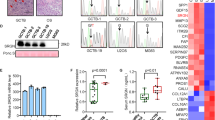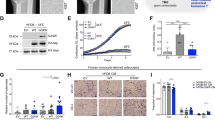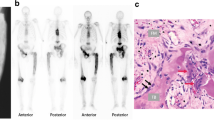Abstract
Hard tissue homeostasis is regulated by the balance between bone formation by osteoblasts and bone resorption by osteoclasts. This physiologic process allows adaptation to mechanical loading and calcium homeostasis. Under pathologic conditions, however, this process is ill-balanced resulting in either over-resorption or over-formation of hard tissue. Local over-resorption by osteoclasts is typically observed in osteolytic metastases of malignancies, autoimmune arthritis, and giant cell tumor of bone (GCTB). In tumor-related local osteolysis, tumor-derived osteoclast-activating factors induce bone resorption not by directly acting on osteoclasts but by indirectly upregulating receptor activator of NFκB ligand (RANKL) on osteoblastic cells. Similarly, synovial tissue in the autoimmune arthritis model does overexpress RANKL and contains numerous osteoclast precursors, and like a landing craft, when it comes in contact with eroded bone surfaces, osteoclast precursors are immediately polarized to become mature osteoclasts, inducing rapidly progressive bone destruction at a late stage of the disease. GCTB, on the other hand, is a common primary bone tumor, usually arising at the metaphysis of the long bone in young adults. After the discovery of RANKL, the concept of GCTB as a tumor of RANKL-expressing stromal cells was established, and comprehensive exosome studies finally disclosed the causative single-point mutation at histone H3.3 (H3F3A) in stromal cells. Thus, osteolytic lesions under various pathological conditions are ultimately attributable to the overexpression of RANKL, which opens up a common, practical and useful therapeutic target for diverse osteolytic conditions.






Similar content being viewed by others
References
Abdelgawad ME, Delaisse JM, Hinge M, Jensen PR, Alnaimi RW, Rolighed L, Engelholm LH, Marcussen N, Andersen TL (2016) Early reversal cells in adult human bone remodeling: osteoblastic nature, catabolic functions and interactions with osteoclasts. Histochem Cell Biol 145(6):603–615. https://doi.org/10.1007/s00418-016-1414-y
Behjati S, Tarpey PS, Presneau N, Scheipl S, Pillay N, Van Loo P, Wedge DC, Cooke SL, Gundem G, Davies H, Nik-Zainal S, Martin S, McLaren S, Goodie V, Robinson B, Butler A, Teague JW, Halai D, Khatri B, Myklebost O, Baumhoer D, Jundt G, Hamoudi R, Tirabosco R, Amary MF, Futreal PA, Stratton MR, Campbell PJ, Flanagan AM (2013) Distinct H3F3A and H3F3B driver mutations define chondroblastoma and giant cell tumor of bone. Nat Genet 45(12):1479–1482. https://doi.org/10.1038/ng.2814
Branstetter DG, Nelson SD, Manivel JC, Blay JY, Chawla S, Thomas DM, Jun S, Jacobs I (2012) Denosumab induces tumor reduction and bone formation in patients with giant-cell tumor of bone. Clin Cancer Res 18(16):4415–4424. https://doi.org/10.1158/1078-0432.CCR-12-0578
Buenzli PR, Jeon J, Pivonka P, Smith DW, Cummings PT (2012) Investigation of bone resorption within a cortical basic multicellular unit using a lattice-based computational model. Bone 50(1):378–389. https://doi.org/10.1016/j.bone.2011.10.021
Bukari BA, Citartan M, Ch’ng ES, Bilibana MP, Rozhdestvensky T, Tang TH (2017) Aptahistochemistry in diagnostic pathology: technical scrutiny and feasibility. Histochem Cell Biol 147(5):545–553. https://doi.org/10.1007/s00418-017-1561-9
Cafforio P, Savonarola A, Stucci S, De Matteo M, Tucci M, Brunetti AE, Vecchio VM, Silvestris F (2014) PTHrP produced by myeloma plasma cells regulates their survival and pro-osteoclast activity for bone disease progression. J Bone Miner Res 29(1):55–66. https://doi.org/10.1002/jbmr.2022
Chen X, Wang Z, Duan N, Zhu G, Schwarz EM, Xie C (2017) Osteoblast–osteoclast interactions. Connect Tissue Res. https://doi.org/10.1080/03008207.2017.1290085
Dougall WC, Holen I, Gonzalez Suarez E (2014) Targeting RANKL in metastasis. Bonekey Rep 3:519. https://doi.org/10.1038/bonekey.2014.14
Fahimi HD (1973) Diffusion artifacts in cytochemistry of catalase. J Histochem Cytochem 21(11):999–1009. https://doi.org/10.1177/21.11.999
Frost HM (1992) Perspectives: bone’s mechanical usage windows. Bone Miner 19(3):257–271
Ghert M, Simunovic N, Cowan RW, Colterjohn N, Singh G (2007) Properties of the stromal cell in giant cell tumor of bone. Clin Orthop Relat Res 459:8–13. https://doi.org/10.1097/BLO.0b013e31804856a1
Gonzalez-Chavez SA, Pacheco-Tena C, Macias-Vazquez CE, Luevano-Flores E (2013) Assessment of different decalcifying protocols on osteopontin and osteocalcin immunostaining in whole bone specimens of arthritis rat model by confocal immunofluorescence. Int J Clin Exp Pathol 6(10):1972–1983
Gyoja F (2017) Basic helix-loop-helix transcription factors in evolution: roles in development of mesoderm and neural tissues. Genesis. https://doi.org/10.1002/dvg.23051
Johnson RW, Suva LJ (2017) Hallmarks of bone metastasis. Calcif Tissue Int. https://doi.org/10.1007/s00223-017-0362-4
Katagiri T, Takahashi N (2002) Regulatory mechanisms of osteoblast and osteoclast differentiation. Oral Dis 8(3):147–159
Kinomura M, Shimada N, Nishikawa M, Omori K, Jo T, Ueda Y, Notohara K, Kitazawa R, Kitazawa S, Fukushima M, Asano K (2015) Parathyroid hormone-related peptide-producing multiple myeloma and renal impairment. Intern Med 54(23):3029–3033. https://doi.org/10.2169/internalmedicine.54.5085
Kitazawa S, Kitazawa R (2002) RANK ligand is a prerequisite for cancer-associated osteolytic lesions. J Pathol 198(2):228–236. https://doi.org/10.1002/path.1199
Kitazawa S, Kitazawa R, Maeda S (1999) In situ hybridization with polymerase chain reaction-derived single-stranded DNA probe and S1 nuclease. Histochem Cell Biol 111(1):7–12
Kitazawa R, Kitazawa S, Kajimoto K, Sowa H, Sugimoto T, Matsui T, Chihara K, Maeda S (2002) Expression of parathyroid hormone-related protein (PTHrP) in multiple myeloma. Pathol Int 52(1):63–68
Kohno N, Kitazawa S, Sakoda Y, Kanbara Y, Furuya Y, Ohashi O, Kitazawa R (1994) Parathyroid hormone-related protein in breast cancer tissues: relationship between primary and metastatic sites. Breast Cancer 1(1):43–49
Lacey DL, Timms E, Tan HL, Kelley MJ, Dunstan CR, Burgess T, Elliott R, Colombero A, Elliott G, Scully S, Hsu H, Sullivan J, Hawkins N, Davy E, Capparelli C, Eli A, Qian YX, Kaufman S, Sarosi I, Shalhoub V, Senaldi G, Guo J, Delaney J, Boyle WJ (1998) Osteoprotegerin ligand is a cytokine that regulates osteoclast differentiation and activation. Cell 93(2):165–176
Le Pape F, Vargas G, Clezardin P (2016) The role of osteoclasts in breast cancer bone metastasis. J Bone Oncol 5(3):93–95. https://doi.org/10.1016/j.jbo.2016.02.008
Lindroth AM, Plass C (2013) Recurrent H3.3 alterations in childhood tumors. Nat Genet 45(12):1413–1414. https://doi.org/10.1038/ng.2832
Liu W, Vivian CJ, Brinker AE, Hampton KR, Lianidou E, Welch DR (2014) Microenvironmental influences on metastasis suppressor expression and function during a metastatic cell’s journey. Cancer Microenviron 7(3):117–131. https://doi.org/10.1007/s12307-014-0148-4
Lopez IA, Ishiyama G, Hosokawa S, Hosokawa K, Acuna D, Linthicum FH, Ishiyama A (2016) Immunohistochemical techniques for the human inner ear. Histochem Cell Biol 146(4):367–387. https://doi.org/10.1007/s00418-016-1471-2
Ludwig RJ, Vanhoorelbeke K, Leypoldt F, Kaya Z, Bieber K, McLachlan SM, Komorowski L, Luo J, Cabral-Marques O, Hammers CM, Lindstrom JM, Lamprecht P, Fischer A, Riemekasten G, Tersteeg C, Sondermann P, Rapoport B, Wandinger KP, Probst C, El Beidaq A, Schmidt E, Verkman A, Manz RA, Nimmerjahn F (2017) Mechanisms of autoantibody-induced pathology. Front Immunol 8:603. https://doi.org/10.3389/fimmu.2017.00603
Martin TJ, Ng KW (1994) Mechanisms by which cells of the osteoblast lineage control osteoclast formation and activity. J Cell Biochem 56(3):357–366. https://doi.org/10.1002/jcb.240560312
Martin TJ, Suva LJ (1988) Parathyroid hormone-related protein: a novel gene product. Baillieres Clin Endocrinol Metab 2(4):1003–1029
Matsuo K, Irie N (2008) Osteoclast–osteoblast communication. Arch Biochem Biophys 473(2):201–209. https://doi.org/10.1016/j.abb.2008.03.027
Mbalaviele G, Novack DV, Schett G, Teitelbaum SL (2017) Inflammatory osteolysis: a conspiracy against bone. J Clin Invest 127(6):2030–2039. https://doi.org/10.1172/JCI93356
McCarthy EF (1980) Giant-cell tumor of bone: an historical perspective. Clin Orthop Relat Res (153):14–25
Mori H, Kitazawa R, Mizuki S, Nose M, Maeda S, Kitazawa S (2002) RANK ligand, RANK, and OPG expression in type II collagen-induced arthritis mouse. Histochem Cell Biol 117(3):283–292. https://doi.org/10.1007/s00418-001-0376-9
Nohr E, Lee LH, Cates JM, Perizzolo M, Itani D (2017) Diagnostic value of histone 3 mutations in osteoclast-rich bone tumors. Hum Pathol 68:119–127. https://doi.org/10.1016/j.humpath.2017.08.030
Orr C, Vieira-Sousa E, Boyle DL, Buch MH, Buckley CD, Canete JD, Catrina AI, Choy EHS, Emery P, Fearon U, Filer A, Gerlag D, Humby F, Isaacs JD, Just SA, Lauwerys BR, Le Goff B, Manzo A, McGarry T, McInnes IB, Najm A, Pitzalis C, Pratt A, Smith M, Tak PP, Thurlings R, Fonseca JE, Veale DJ (2017) Synovial tissue research: a state-of-the-art review. Nat Rev Rheumatol 13(8):463–475. https://doi.org/10.1038/nrrheum.2017.115
Ottewell PD, O’Donnell L, Holen I (2015) Molecular alterations that drive breast cancer metastasis to bone. Bonekey Rep 4:643. https://doi.org/10.1038/bonekey.2015.10
Piemontese M, Almeida M, Robling AG, Kim HN, Xiong J, Thostenson JD, Weinstein RS, Manolagas SC, O’Brien CA, Jilka RL (2017) Old age causes de novo intracortical bone remodeling and porosity in mice. JCI Insight. https://doi.org/10.1172/jci.insight.93771
Roux S, Meignin V, Quillard J, Meduri G, Guiochon-Mantel A, Fermand JP, Milgrom E, Mariette X (2002) RANK (receptor activator of nuclear factor-kappaB) and RANKL expression in multiple myeloma. Br J Haematol 117(1):86–92
Schwartzentruber J, Korshunov A, Liu XY, Jones DT, Pfaff E, Jacob K, Sturm D, Fontebasso AM, Quang DA, Tonjes M, Hovestadt V, Albrecht S, Kool M, Nantel A, Konermann C, Lindroth A, Jager N, Rausch T, Ryzhova M, Korbel JO, Hielscher T, Hauser P, Garami M, Klekner A, Bognar L, Ebinger M, Schuhmann MU, Scheurlen W, Pekrun A, Fruhwald MC, Roggendorf W, Kramm C, Durken M, Atkinson J, Lepage P, Montpetit A, Zakrzewska M, Zakrzewski K, Liberski PP, Dong Z, Siegel P, Kulozik AE, Zapatka M, Guha A, Malkin D, Felsberg J, Reifenberger G, von Deimling A, Ichimura K, Collins VP, Witt H, Milde T, Witt O, Zhang C, Castelo-Branco P, Lichter P, Faury D, Tabori U, Plass C, Majewski J, Pfister SM, Jabado N (2012) Driver mutations in histone H3.3 and chromatin remodelling genes in paediatric glioblastoma. Nature 482(7384):226–231. https://doi.org/10.1038/nature10833
Sims NA, Martin TJ (2014) Coupling the activities of bone formation and resorption: a multitude of signals within the basic multicellular unit. Bonekey Rep 3:481. https://doi.org/10.1038/bonekey.2013.215
Singh T, Kaur V, Kumar M, Kaur P, Murthy RS, Rawal RK (2015) The critical role of bisphosphonates to target bone cancer metastasis: an overview. J Drug Target 23(1):1–15. https://doi.org/10.3109/1061186X.2014.950668
Sobti A, Agrawal P, Agarwala S, Agarwal M (2016) Giant cell tumor of bone—an overview. Arch Bone Jt Surg 4(1):2–9
Suva LJ, Winslow GA, Wettenhall RE, Hammonds RG, Moseley JM, Diefenbach-Jagger H, Rodda CP, Kemp BE, Rodriguez H, Chen EY et al (1987) A parathyroid hormone-related protein implicated in malignant hypercalcemia: cloning and expression. Science 237(4817):893–896
Teitelbaum SL (2006) Osteoclasts; culprits in inflammatory osteolysis. Arthritis Res Ther 8(1):201. https://doi.org/10.1186/ar1857
Teitelbaum SL, Abu-Amer Y, Ross FP (1995) Molecular mechanisms of bone resorption. J Cell Biochem 59(1):1–10. https://doi.org/10.1002/jcb.240590102
Terpos E, Christoulas D, Gavriatopoulou M, Dimopoulos MA (2017) Mechanisms of bone destruction in multiple myeloma. Eur J Cancer Care (Engl). https://doi.org/10.1111/ecc.12761
Theriault RL, Theriault RL (2012) Biology of bone metastases. Cancer Control 19(2):92–101. https://doi.org/10.1177/107327481201900203
Tsuboi K, Hasegawa T, Yamamoto T, Sasaki M, Hongo H, de Freitas PH, Shimizu T, Takahata M, Oda K, Michigami T, Li M, Kitagawa Y, Amizuka N (2016) Effects of drug discontinuation after short-term daily alendronate administration on osteoblasts and osteocytes in mice. Histochem Cell Biol 146(3):337–350. https://doi.org/10.1007/s00418-016-1450-7
Udagawa N, Kotake S, Kamatani N, Takahashi N, Suda T (2002) The molecular mechanism of osteoclastogenesis in rheumatoid arthritis. Arthritis Res 4(5):281–289. https://doi.org/10.1186/ar431
van der Heijden L, Dijkstra PDS, Blay JY, Gelderblom H (2017) Giant cell tumour of bone in the denosumab era. Eur J Cancer 77:75–83. https://doi.org/10.1016/j.ejca.2017.02.021
von Wasielewski R, Werner M, Nolte M, Wilkens L, Georgii A (1994) Effects of antigen retrieval by microwave heating in formalin-fixed tissue sections on a broad panel of antibodies. Histochemistry 102(3):165–172
Wallington EA (1979) Artifacts in tissue sections. Med Lab Sci 36(1):3–61
Wang H, Wan N, Hu Y (2012) Giant cell tumour of bone: a new evaluating system is necessary. Int Orthop 36(12):2521–2527. https://doi.org/10.1007/s00264-012-1664-9
Werner M (2006) Giant cell tumour of bone: morphological, biological and histogenetical aspects. Int Orthop 30(6):484–489. https://doi.org/10.1007/s00264-006-0215-7
Wu G, Broniscer A, McEachron TA, Lu C, Paugh BS, Becksfort J, Qu C, Ding L, Huether R, Parker M, Zhang J, Gajjar A, Dyer MA, Mullighan CG, Gilbertson RJ, Mardis ER, Wilson RK, Downing JR, Ellison DW, Zhang J, Baker SJ, St. Jude Children’s Research Hospital–Washington University Pediatric Cancer Genome P (2012) Somatic histone H3 alterations in pediatric diffuse intrinsic pontine gliomas and non-brainstem glioblastomas. Nat Genet 44(3):251–253. https://doi.org/10.1038/ng.1102
Wu C, Sun Z, Guo B, Ye Y, Han X, Qin Y, Liu S (2017) Osthole inhibits bone metastasis of breast cancer. Oncotarget 8(35):58480–58493. https://doi.org/10.18632/oncotarget.17024
Xu L, Mohammad KS, Wu H, Crean C, Poteat B, Cheng Y, Cardoso AA, Machal C, Hanenberg H, Abonour R, Kacena MA, Chirgwin J, Suvannasankha A, Srour EF (2016) Cell adhesion molecule CD166 drives malignant progression and osteolytic disease in multiple myeloma. Cancer Res 76(23):6901–6910. https://doi.org/10.1158/0008-5472.CAN-16-0517
Yamada Y, Kinoshita I, Kenichi K, Yamamoto H, Iwasaki T, Otsuka H, Yoshimoto M, Ishihara S, Toda Y, Kuma Y, Setsu N, Koga Y, Honda Y, Inoue T, Yanai H, Yamashita K, Ito I, Takahashi M, Ohga S, Furue M, Nakashima Y, Oda Y (2017) Histopathological and genetic review of phosphaturic mesenchymal tumours, mixed connective tissue variant. Histopathology. https://doi.org/10.1111/his.13377
Yamamoto H, Iwasaki T, Yamada Y, Matsumoto Y, Otsuka H, Yoshimoto M, Kohashi K, Taguchi K, Yokoyama R, Nakashima Y, Oda Y (2017) Diagnostic utility of histone H3.3G34 W, G34R, and G34 V mutant-specific antibodies for giant cell tumors of bone. Hum Pathol. https://doi.org/10.1016/j.humpath.2017.11.020
Yasuda H, Shima N, Nakagawa N, Yamaguchi K, Kinosaki M, Mochizuki S, Tomoyasu A, Yano K, Goto M, Murakami A, Tsuda E, Morinaga T, Higashio K, Udagawa N, Takahashi N, Suda T (1998) Osteoclast differentiation factor is a ligand for osteoprotegerin/osteoclastogenesis-inhibitory factor and is identical to TRANCE/RANKL. Proc Natl Acad Sci USA 95(7):3597–3602
Yoneda T, Tanaka S, Hata K (2013) Role of RANKL/RANK in primary and secondary breast cancer. World J Orthop 4(4):178–185. https://doi.org/10.5312/wjo.v4.i4.178
Yuan L, Chan GC, Fung KL, Chim CS (2014) RANKL expression in myeloma cells is regulated by a network involving RANKL promoter methylation, DNMT1, microRNA and TNFalpha in the microenvironment. Biochim Biophys Acta 1843(9):1834–1838. https://doi.org/10.1016/j.bbamcr.2014.05.010
Acknowledgements
This study was partially supported by a Grant-in-Aid for Scientific Research from the Ministry of Education, Science, Sports and Culture, Japan (to RK, RH and SK).
Author information
Authors and Affiliations
Corresponding author
Ethics declarations
Conflict of interest
The authors declare that they have no conflict of interest.
Rights and permissions
About this article
Cite this article
Kitazawa, R., Haraguchi, R., Fukushima, M. et al. Pathologic conditions of hard tissue: role of osteoclasts in osteolytic lesion. Histochem Cell Biol 149, 405–415 (2018). https://doi.org/10.1007/s00418-018-1639-z
Accepted:
Published:
Issue Date:
DOI: https://doi.org/10.1007/s00418-018-1639-z






